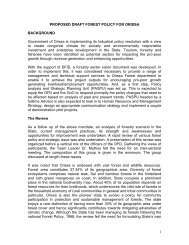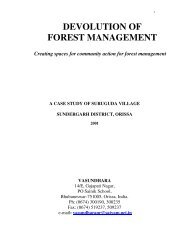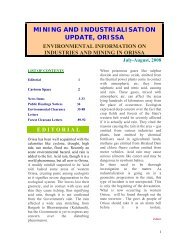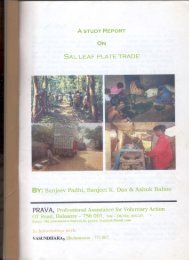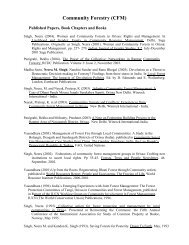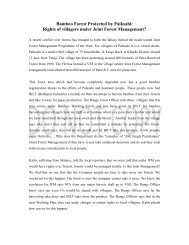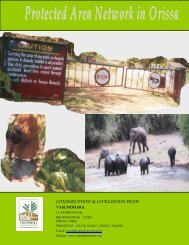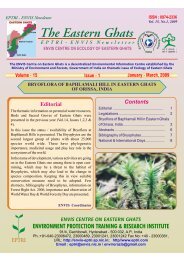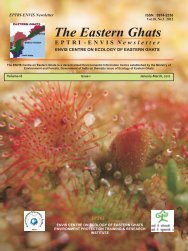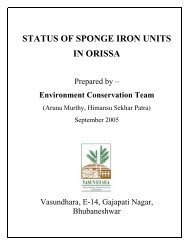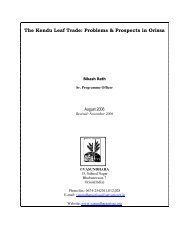Bamboo in Orissa: Trade and Livelihood Perspective - Vasundhara
Bamboo in Orissa: Trade and Livelihood Perspective - Vasundhara
Bamboo in Orissa: Trade and Livelihood Perspective - Vasundhara
You also want an ePaper? Increase the reach of your titles
YUMPU automatically turns print PDFs into web optimized ePapers that Google loves.
All rights reserved by VASUNDHARA(www.vasundharaorissa.org). For any clarification, contact author at sunlit1968@yahoo.co.<strong>in</strong><br />
diverted his attention to bamboo <strong>and</strong> published two papers on the possibility of paper<br />
mak<strong>in</strong>g from bamboo <strong>in</strong> 1875 <strong>and</strong> 1879. This was followed by some more research <strong>and</strong> <strong>in</strong><br />
1908 the Govt of India/Burma sent 8 to 9 tons of bamboo to paper & pulp technologist<br />
Mr.R.W.S<strong>in</strong>dall (Engl<strong>and</strong>) for practical experimental purposes. This bamboo was<br />
converted <strong>in</strong>to paper <strong>and</strong> this paved the way for large scale utilisation of bamboo as a<br />
major raw material <strong>in</strong> the paper <strong>in</strong>dustry (Bhargava, M. 1946; <strong>Bamboo</strong> for Pulp & Paper<br />
Manufacture, Forest Research Institute, Dehradun; pp.1,2).<br />
However, it took a considerable time for bamboo to ga<strong>in</strong> importance <strong>in</strong> the paper <strong>in</strong>dustry.<br />
After World War I, Indian paper mills got a better scope of market<strong>in</strong>g their products for<br />
sometime, but competition with European paper gradually proved quite costlier for them.<br />
Dur<strong>in</strong>g this period of struggle they were badly <strong>in</strong> need of a favourable policy environment<br />
as well as some technical revolution that could save them from the cricis. The Government<br />
therefore established a pilot bamboo pulp<strong>in</strong>g unit <strong>in</strong> 1919 which became operational <strong>in</strong><br />
1924. The mills realised the potential of bamboo <strong>in</strong> their bus<strong>in</strong>ess, but s<strong>in</strong>ce the process of<br />
bamboo pulp<strong>in</strong>g developed very slowly, they had to suffer for some more time. The Indian<br />
Paper Pulp Company was the first mill to develop this process to a considerable extent<br />
(Calcutta Paper <strong>Trade</strong>rs Association 2002-03,<br />
www.papertradekolkata.com/paperorig<strong>in</strong>.htm).<br />
When bamboo established itself <strong>in</strong> the <strong>in</strong>dustry, its scarcity became a matter of concern for<br />
those states which depended on other states for the supply of bamboo. To solve this<br />
problem states like West Bengal tried plantations of Eucalyptus <strong>and</strong> other species of hard<br />
wood, but bamboo was still preferable because it produces the long fibred pulp required for<br />
manufactur<strong>in</strong>g quality paper, which these hard wood substitutes were unable to do<br />
(Calcutta Paper <strong>Trade</strong>rs Association 2002-03, op.cit.).<br />
In 1998, JK Paper Ltd. adopted, for the first time <strong>in</strong> India, the RDH(Rapid Displacement<br />
Heat<strong>in</strong>g) technology which claimed to solve the short-fibre problem of hardwood. Brought<br />
from Germany, this technology was expected to enable the paper <strong>in</strong>dustry to use 100%<br />
hardwood as the raw material, thus completely elim<strong>in</strong>at<strong>in</strong>g, <strong>in</strong> pr<strong>in</strong>ciple atleast, the scope<br />
of us<strong>in</strong>g bamboo. On the other h<strong>and</strong>, developments world-over were gradually reduc<strong>in</strong>g the<br />
importance of long-fibrous production of paper s<strong>in</strong>ce <strong>in</strong>creas<strong>in</strong>g use of computers helped<br />
preservation of huge data <strong>in</strong> the electronic form as a result of which preservation of data on<br />
durable papers was no more thought essential. S<strong>in</strong>ce dem<strong>and</strong> for durable papers got<br />
reduced substantially, hence emphasis of long-fibrous raw material was also<br />
reduced(discussion with S. Jagdev).<br />
<strong>Bamboo</strong> mats have been processed to produce roof<strong>in</strong>g sheets like the asbestos ones;<br />
however be<strong>in</strong>g subjected to heat <strong>and</strong> pressure they develop cracks caus<strong>in</strong>g leakage of water<br />
when used for roof<strong>in</strong>g. Gram Vikash, an NGO, is claimed to have first established an unit<br />
for this purpose(see box under the title ‘PlyBoo: Value addition through reprocess<strong>in</strong>g’) <strong>in</strong><br />
India. Currently other organisations are work<strong>in</strong>g on this <strong>and</strong> leak-proof coat<strong>in</strong>g have been<br />
tried on such sheets to solve the problem.<br />
F<strong>in</strong>e bamboo sticks are used as a stitch<strong>in</strong>g material <strong>in</strong> leaf-plates. They are also used <strong>in</strong><br />
mak<strong>in</strong>g <strong>in</strong>cense sticks.<br />
8



